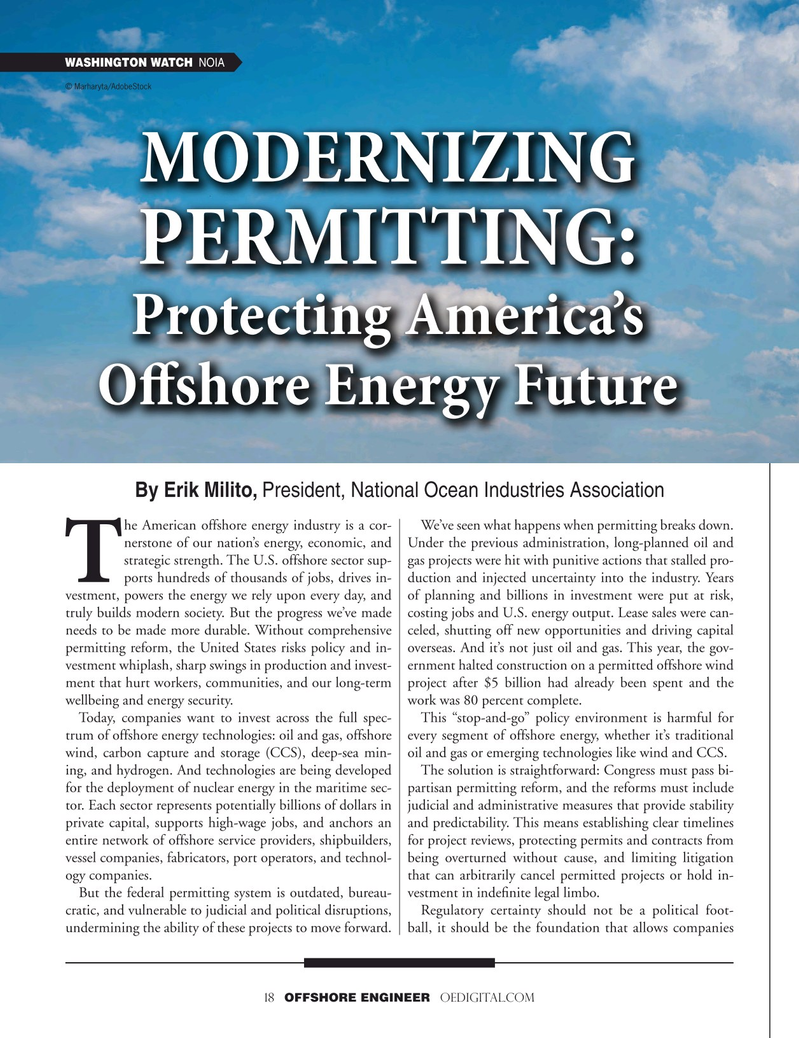
Page 18: of Offshore Engineer Magazine (Sep/Oct 2025)
Read this page in Pdf, Flash or Html5 edition of Sep/Oct 2025 Offshore Engineer Magazine
WASHINGTON WATCH NOIA © Marharyta/AdobeStock
MODERNIZING
PERMITTING:
Protecting America’s
Ofshore Energy Future
By Erik Milito, President, National Ocean Industries Association he American offshore energy industry is a cor- We’ve seen what happens when permitting breaks down. nerstone of our nation’s energy, economic, and Under the previous administration, long-planned oil and strategic strength. The U.S. offshore sector sup- gas projects were hit with punitive actions that stalled pro-
Tports hundreds of thousands of jobs, drives in- duction and injected uncertainty into the industry. Years vestment, powers the energy we rely upon every day, and of planning and billions in investment were put at risk, truly builds modern society. But the progress we’ve made costing jobs and U.S. energy output. Lease sales were can- needs to be made more durable. Without comprehensive celed, shutting off new opportunities and driving capital permitting reform, the United States risks policy and in- overseas. And it’s not just oil and gas. This year, the gov- vestment whiplash, sharp swings in production and invest- ernment halted construction on a permitted offshore wind ment that hurt workers, communities, and our long-term project after $5 billion had already been spent and the wellbeing and energy security. work was 80 percent complete.
Today, companies want to invest across the full spec- This “stop-and-go” policy environment is harmful for trum of offshore energy technologies: oil and gas, offshore every segment of offshore energy, whether it’s traditional wind, carbon capture and storage (CCS), deep-sea min- oil and gas or emerging technologies like wind and CCS.
ing, and hydrogen. And technologies are being developed The solution is straightforward: Congress must pass bi- for the deployment of nuclear energy in the maritime sec- partisan permitting reform, and the reforms must include tor. Each sector represents potentially billions of dollars in judicial and administrative measures that provide stability private capital, supports high-wage jobs, and anchors an and predictability. This means establishing clear timelines entire network of offshore service providers, shipbuilders, for project reviews, protecting permits and contracts from vessel companies, fabricators, port operators, and technol- being overturned without cause, and limiting litigation ogy companies. that can arbitrarily cancel permitted projects or hold in-
But the federal permitting system is outdated, bureau- vestment in indefnite legal limbo. cratic, and vulnerable to judicial and political disruptions, Regulatory certainty should not be a political foot- undermining the ability of these projects to move forward. ball, it should be the foundation that allows companies 18 OFFSHORE ENGINEER OEDIGITAL.COM

 17
17

 19
19